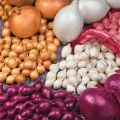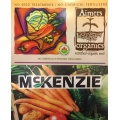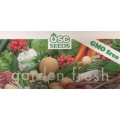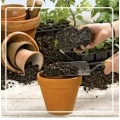Seeds and Supplies
Great selection of seeds and supplies in stock. Please see in store for Selection.Promotion
All Ontario Seed Company (OSC) and Aimers Organic Seeds are 10% Off regular retail price for a limited time. See in store for full selection. Not every item is listed on our website. Seeds are this years supply and are fresh ready to plant
Seeds Chinese Cabbage Michihli OSC Seed Packet
Dark green exterior leaves hide a solid interior of beautifully blanched spicy tasting leaves that are tender and crisp. Heads have a pronounced taper towards the tip and average 45 cm (18″) high and 10 cm (4″) in diameter. Very large, spicy leaves are produced prior to heading-up. Best grown late summer into fall. Optimum Growing Conditions are cool days 12 – 21 C (55-70°F) with cool to cold nights 4 – 10 C (40-50°F).
How to Grow
. Sow seed indoors in a soil-less mix 5 weeks before last frost date. Sow seed 6 mm (1/4″) deep and keep at 20 C (70 F) for the 7-10 day germination period. Grow on at a slightly cooler temperature then harden off and plant outside in late May. Space plants 45 cm (18″) apart in rows with the rows 75 cm (30″) apart. Spring to summer crops will not form dense heads. For better results plant in late summer for fall harvests. Optimum Growing Conditions: Cool days 12 – 21 C (55-70°F) with cool to cold nights 4 – 10 C (40-50°F).
Seeds Chives Aimers Organic Seed Packet
Sow chive seeds at any time of year. Hardy, perennial, and easy to grow, the chopped stems and pink flowers add a fresh, mild green onion flavour to sandwiches, salads and baked potatoes. Clumps can be divided in spring or fall. If grown in containers, divide frequently enough to provide for constant lateral growth. Chives are surprisingly hardy and can be harvested all winter if given some protection from extreme cold. They are also quite drought tolerant, so they're good candidates for xeriscaping. The edible flowers are highly attractive to bumblebees, hoverflies, and other beneficial garden insects.
Seeds Chives OSC Seed Packet
Chive seeds grow as tufts of grassy, tubular leaves shaped much like miniature onion leaves. Use the delicate, mild onion-flavoured leaves in salads, soups, stews, omelettes and dips. Plants grow in clusters to 15 cm (6″) high and produce pretty, edible, purple ball-shaped flowers about 2.5 cm (1″) in diameter. Often gardeners find chives spreading throughout the garden easily on their own. Despite this, chives can be a fussy germinator, with the seed sometimes taking much longer to emerge than expected. While it often spreads from established plants by self-seeding, it is not considered invasive.
Perennial hardy to Zone 3.
How to Grow
Sow seed directly outdoors in a sunny site with average soil in mid-to-late May or in August through September. Sow seed 6 mm (1/4″) deep and 2.5 cm (1″) apart then thin to 10 cm (4″) apart in the garden. Note that germination normally occurs within 14 days of sowing, however seed can sometimes take much longer to sprout so be patient.
Seeds Cucumber Burless Hybrid OSC Seed Packet
Slicing Type. Crisp, tasty, not bitter and truly burpless – need you look further for a better slicing cucumber! These cucumbers may be eaten without peeling, just like celery. Peak flavour and vitamin content is reached when 20-25 cm (8-10″) long. Packet contains 20 seeds.
How to Grow
Cucumbers grow best in a rich, warm, sandy loam soil. Before planting, work into the native soil 30 cm (12″) deep large amounts of garden compost or composted manure. As cooler soil will reduce germination and increase the chance of the seed rotting before it sprouts, wait until the soil has reached a temperature of at least 18 C (66 F) before planting. Mound the soil up into hills about 15-20 cm (6-8″) high and about 30-60 cm (12-24″) across. Space the hills about 120 cm (4′) apart. Sow the seed 2 cm (3/4″) deep with 6 to 8 seeds per hill then after the seed sprouts, thin to 3 or 4 plants per hill. If you have limited space, most cucumbers grow on trellises. Protect the plants from any late spring/early summer frosts and keep the plants evenly watered through the growing season. Even soil moisture is very important as cucumbers become very bitter if the plant becomes moisture stressed by hot dry weather. To prevent damage to the plant, harvest the cucumbers by cutting them from the vine with a sharp knife – do not pull or twist them from the vine.
Seeds Cucumber Chicago Pickling OSC Seed Packet
Chicago Cucumber Seeds (Pickling Type) 1605 Heirloom Vegetable. Heavy yielding plants are loaded with perfectly formed, deep green fruit with black spines. The thin skin allows for ready absorption of pickling solutions and while fruit can be allowed to reach up to 12.5 cm (5″) in length without sacrificing quality, they are most often picked at a much smaller size for the “best gherkins” this side of Chicago! Resistant to scab and cucumber mosaic virus. Introduced in 1888.
How to Grow
Cucumbers grow best in a rich, warm, sandy loam soil. Before planting, work into the native soil 30 cm (12″) deep large amounts of garden compost or composted manure. As cooler soil will reduce germination and increase the chance of the seed rotting before it sprouts, wait until the soil has reached a temperature of at least 18 C (66 F) before planting. Mound the soil up into hills about 15-20 cm (6-8″) high and about 30-60 cm (12-24″) across. Space the hills about 120 cm (4′) apart. Sow the seed 2 cm (3/4″) deep with 6 to 8 seeds per hill then after the seed sprouts, thin to 3 or 4 plants per hill. If you have limited space, most cucumbers grow on trellises. Protect the plants from any late spring/early summer frosts and keep the plants evenly watered through the growing season. Even soil moisture is very important as cucumbers become very bitter if the plant becomes moisture stressed by hot dry weather. To prevent damage to the plant, harvest the cucumbers by cutting them from the vine with a sharp knife – do not pull or twist them from the vine.
Seeds Cucumber English Telegraph OSC Seed Packet
English Telegraph (also known as the ‘English Cucumber’) has been around since at least 1885 and produces a straight, slim slicing cucumber. The fruit averages 35 cm (14″) long and has a very mild flavour. Fruit that develops on vines laying on the ground often curl so for your best chance at straight fruit, train vines to grow on a trellis or netting. Continuously pick the fruit to encourage further flower and fruit production. For those of you lucky enough to have your own greenhouse, this is one variety to give a try indoors.
How to Grow
Cucumbers grow best in a rich, warm, sandy loam soil. Before planting, work into the native soil 30 cm (12″) deep large amounts of garden compost or composted manure. As cooler soil will reduce germination and increase the chance of the seed rotting before it sprouts, wait until the soil has reached a temperature of at least 18 C (66 F) before planting. Mound the soil up into hills about 15-20 cm (6-8″) high and about 30-60 cm (12-24″) across. Space the hills about 120 cm (4′) apart. Sow the seed 2 cm (3/4″) deep with 6 to 8 seeds per hill then after the seed sprouts, thin to 3 or 4 plants per hill. If you have limited space, most cucumbers can be trained to grow on trellises and in the case of English Telegraph it is highly recommended to grow them vertically on trellis or netting. Protect the plants from any late spring/early summer frosts and keep the plants evenly watered through the growing season. Even soil moisture is very important as cucumbers become very bitter if the plant becomes moisture stressed by hot dry weather. To prevent damage to the plant, harvest the cucumbers by cutting them from the vine with a sharp knife – do not pull or twist them from the vine.
Seeds Cucumber Marketmore 76 Aimers Organic Seed Packet
Marketmore Cucumber Seeds (Slicing Type) . A high yielding variety producing perfectly shaped, uniform, dark green cucumbers 20-22 cm (8-9″) long. Superb for slicing. Highly disease resistant. Resistant to mosaic, scab & more.
How to Grow
Cucumbers grow best in a rich, warm, sandy loam soil. Before planting, work into the native soil 30 cm (12″) deep large amounts of garden compost or composted manure. As cooler soil will reduce germination and increase the chance of the seed rotting before it sprouts, wait until the soil has reached a temperature of at least 18 C (66 F) before planting. Mound the soil up into hills about 15-20 cm (6-8″) high and about 30-60 cm (12-24″) across. Space the hills about 120 cm (4′) apart. Sow the seed 2 cm (3/4″) deep with 6 to 8 seeds per hill then after the seed sprouts, thin to 3 or 4 plants per hill. If you have limited space, most cucumbers grow on trellises. Protect the plants from any late spring/early summer frosts and keep the plants evenly watered through the growing season. Even soil moisture is very important as cucumbers become very bitter if the plant becomes moisture stressed by hot dry weather. To prevent damage to the plant, harvest the cucumbers by cutting them from the vine with a sharp knife – do not pull or twist them from the vine.
Seeds Cucumber Marketmore OSC Seed Packet
Marketmore Cucumber Seeds (Slicing Type) . A high yielding variety producing perfectly shaped, uniform, dark green cucumbers 20-22 cm (8-9″) long. Superb for slicing. Highly disease resistant. Resistant to mosaic, scab & more.
How to Grow
Cucumbers grow best in a rich, warm, sandy loam soil. Before planting, work into the native soil 30 cm (12″) deep large amounts of garden compost or composted manure. As cooler soil will reduce germination and increase the chance of the seed rotting before it sprouts, wait until the soil has reached a temperature of at least 18 C (66 F) before planting. Mound the soil up into hills about 15-20 cm (6-8″) high and about 30-60 cm (12-24″) across. Space the hills about 120 cm (4′) apart. Sow the seed 2 cm (3/4″) deep with 6 to 8 seeds per hill then after the seed sprouts, thin to 3 or 4 plants per hill. If you have limited space, most cucumbers grow on trellises. Protect the plants from any late spring/early summer frosts and keep the plants evenly watered through the growing season. Even soil moisture is very important as cucumbers become very bitter if the plant becomes moisture stressed by hot dry weather. To prevent damage to the plant, harvest the cucumbers by cutting them from the vine with a sharp knife – do not pull or twist them from the vine.
Seeds Cucumber Straight Eight OSC Seed Packet
Straight Eight Cucumber Seeds (Slicing Type) Heirloom Vegetable. Like a trusted friend, this variety can always be counted on to come through! An old favourite that produces outstanding yields of straight, 20 cm (8″) long, smooth skinned, dark green cucumbers. Great for slicing or for using in relishes. A proven performer in all situations: the market garden, the backyard garden & greenhouse! A 1935 All-America winner.
How to Grow
Cucumbers grow best in a rich, warm, sandy loam soil. Before planting, work into the native soil 30 cm (12″) deep large amounts of garden compost or composted manure. As cooler soil will reduce germination and increase the chance of the seed rotting before it sprouts, wait until the soil has reached a temperature of at least 18 C (66 F) before planting. Mound the soil up into hills about 15-20 cm (6-8 “) high and about 30-60 cm (12-24 “) across. Space the hills about 120 cm (4 ‘) apart. Sow the seed 2 cm (3/4 “) deep with 6 to 8 seeds per hill then after the seed sprouts, thin to 3 or 4 plants per hill. If you have limited space, most cucumbers grow on trellises. Protect the plants from any late spring/early summer frosts and keep the plants evenly watered through the growing season. Even soil moisture is very important as cucumbers become very bitter if the plant becomes moisture stressed by hot dry weather. To prevent damage to the plant, harvest the cucumbers by cutting them from the vine with a sharp knife – do not pull or twist them from the vine.
Seeds Cucumber Wisconsin SMR 58 Aimers Organic Seed Packet
Wisconsin SMR-58 Cucumber Seeds (Pickling Type) 1620 Heirloom Vegetable. The best disease resistant pickling variety. This black spined variety has medium green fruits that taper at both ends. It is a very popular variety with commercial growers. Resistant to scab and cucumber mosaic virus. This variety is an ideal choice for growers in Ontario, Quebec, the Prairies & the Maritimes. Introduced in 1958.
How to Grow
Cucumbers grow best in a rich, warm, sandy loam soil. Before planting, work into the native soil 30 cm (12″) deep large amounts of garden compost or composted manure. As cooler soil will reduce germination and increase the chance of the seed rotting before it sprouts, wait until the soil has reached a temperature of at least 18 C (66 F) before planting. Mound the soil up into hills about 15-20 cm (6-8″) high and about 30-60 cm (12-24″) across. Space the hills about 120 cm (4′) apart. Sow the seed 2 cm (3/4″) deep with 6 to 8 seeds per hill then after the seed sprouts, thin to 3 or 4 plants per hill. If you have limited space, most cucumbers grow on trellises. Protect the plants from any late spring/early summer frosts and keep the plants evenly watered through the growing season. Even soil moisture is very important as cucumbers become very bitter if the plant becomes moisture stressed by hot dry weather. To prevent damage to the plant, harvest the cucumbers by cutting them from the vine with a sharp knife – do not pull or twist them from the vine.
Seeds Cucumber Wisconsin SMR 58 OSC Seed Packet
Wisconsin SMR-58 Cucumber Seeds (Pickling Type) 1620 Heirloom Vegetable. The best disease resistant pickling variety. This black spined variety has medium green fruits that taper at both ends. It is a very popular variety with commercial growers. Resistant to scab and cucumber mosaic virus. This variety is an ideal choice for growers in Ontario, Quebec, the Prairies & the Maritimes. Introduced in 1958.
How to Grow
Cucumbers grow best in a rich, warm, sandy loam soil. Before planting, work into the native soil 30 cm (12″) deep large amounts of garden compost or composted manure. As cooler soil will reduce germination and increase the chance of the seed rotting before it sprouts, wait until the soil has reached a temperature of at least 18 C (66 F) before planting. Mound the soil up into hills about 15-20 cm (6-8″) high and about 30-60 cm (12-24″) across. Space the hills about 120 cm (4′) apart. Sow the seed 2 cm (3/4″) deep with 6 to 8 seeds per hill then after the seed sprouts, thin to 3 or 4 plants per hill. If you have limited space, most cucumbers grow on trellises. Protect the plants from any late spring/early summer frosts and keep the plants evenly watered through the growing season. Even soil moisture is very important as cucumbers become very bitter if the plant becomes moisture stressed by hot dry weather. To prevent damage to the plant, harvest the cucumbers by cutting them from the vine with a sharp knife – do not pull or twist them from the vine.
Seeds Dill Aimers Organic Seed Packet
dill seeds produce a plant that should be a part of any herb garden. Seeds grown from the plant and foliage can be used to flavour foods and are especially important in the flavouring of vinegar and pickles. Dill is regularly used in gardens as a quick growing attractant for beneficial insects such as lace wings, lady bugs, hover flies and parasitic wasps as well as a food source for butterflies and other pollinators. This pretty annual herb grows to 90 cm (3′) in height.
How to Grow
Sow seed outdoors in mid to late May, then every two weeks through to the end of June. Dill is a low maintenance plant & prolific grower — all you really need to do is provide water when necessary. Lightly feed with a general-purpose fertilizer as too much can adversely affect the production of the essential oils responsible for flavour and aroma. Dill is grown for its leaves and seeds.
Seeds Dill OSC Seed Packet
dill seeds produce a plant that should be a part of any herb garden. Seeds grown from the plant and foliage can be used to flavour foods and are especially important in the flavouring of vinegar and pickles. Dill is regularly used in gardens as a quick growing attractant for beneficial insects such as lace wings, lady bugs, hover flies and parasitic wasps as well as a food source for butterflies and other pollinators. This pretty annual herb grows to 90 cm (3′) in height.
How to Grow
Sow seed outdoors in mid to late May, then every two weeks through to the end of June. Dill is a low maintenance plant & prolific grower — all you really need to do is provide water when necessary. Lightly feed with a general-purpose fertilizer as too much can adversely affect the production of the essential oils responsible for flavour and aroma. Dill is grown for its leaves and seeds.
Seeds Fennel OSC Seed Packet
Florence Fennel seeds produce a plant with a swollen, bulbous base that has a pleasing anise-like flavour. It is absolutely superb when used raw in salads or cooked in chicken dishes. Above the bulbous root, lacy carrot-like foliage grows to about 75 cm (2.5′) high. Interestingly, many gardeners report that their younger children really appreciate fennel’s irresistible aroma and taste. Some gardeners also report that fennel seems to inhibit bean and tomato growth if roots of these plants intermingle. Fennel, like dill, also attracts a range of beneficial insects to the garden.
Annual.
How to Grow
Sow seed directly outdoors in a sunny site with average soil in mid-to-late May. Seed can also be started indoors in a soil-less mix 8 weeks before last frost date. Keep temperature at 21 C (70 F) for the 10-14 day germination period, then grow on at a slightly cooler temperature before hardening off and transplanting outside after the danger of frost has passed. Sow seed 3 mm (1/8″) deep and 2.5 cm (1″) apart then thin to 25-30 cm (10-12″) apart in the garden. It is our experience that direct sowing works best with fennel.
Seeds Kale Red Russian Aimers Organic Seed Packet
Heirloom Vegetable. Red Russian produces lots of flat toothed, grey-green leaves with a central purple-red stem. The red colour intensifies as temperatures decreases in the fall. Leaves turns a rich, dark green when cooked. Soft tender texture when braised or for salads. Red Russian Kale is vitamin rich and very winter hardy. This kale variety arrived in Canada somewhere around 1885.
How to Grow
Sow seed directly outdoors 1 cm (1/2″) deep in early spring or from June to early July in rows 60 cm (24″) apart. Thin seedlings to 30 cm (12″) apart. Kale is very cold tolerant and develops its best flavour after the fall frosts.
Seeds Kale Red Russian OSC Seed Packet
Heirloom Vegetable. Red Russian produces lots of flat toothed, grey-green leaves with a central purple-red stem. The red colour intensifies as temperatures decreases in the fall. Leaves turns a rich, dark green when cooked. Soft tender texture when braised or for salads. Red Russian Kale is vitamin rich and very winter hardy. This kale variety arrived in Canada somewhere around 1885.
How to Grow
Sow seed directly outdoors 1 cm (1/2″) deep in early spring or from June to early July in rows 60 cm (24″) apart. Thin seedlings to 30 cm (12″) apart. Kale is very cold tolerant and develops its best flavour after the fall frosts.
Seeds Kohl Rabi Purple Vienna OSC Seed Packet
Heirloom Vegetable. This handsome purple, pre-1860 variety has a white, crisp, mild tasting interior. Flesh has a nutty flavour when eaten raw and a mild cabbage taste when cooked. An excellent companion plant amongst cucumbers. Irrigation is essential for best growth. Purple Vienna withstands considerable frost and when conditions are not too cool or too hot, crops can be harvested as little as six to eight weeks after sowing but are best when the stem reaches 5-7.5 cm (2-3″) in diameter. Try successive sowings two weeks apart from April through to early August.
How to Grow
Sow seed directly outdoors anytime from late April to late July 1 cm (1/2″) deep and 2.5 cm (1″) apart. Space rows 30-45 cm (12-18″) apart. Thin emerging seedlings to 10 cm (4″) apart in the row.
Seeds Kohl Rabi White Vienna OSC Seed Packet
Heirloom Vegetable. This rapidly growing member of the cabbage family produces a greenish-white enlarged stem with short tops and few leaves. Slow to bolt and early producing, White Vienna is best harvested when the stem reaches 5-7.5 cm (2-3″) in diameter. For best growth, irrigation is essential through dry periods. Flesh is white with a nutty flavour when eaten raw and a mild cabbage taste when cooked. Sow seed every two weeks from April through to early August. Like Purple Vienna Kohlrabi, White Vienna is a pre-1860 variety.
How to Grow
Sow seed directly outdoors anytime from late April to late July 1 cm (1/2″) deep and 2.5 cm (1″) apart. Space rows 30-45 cm (12-18″) apart. Thin emerging seedlings to 10 cm (4″) apart in the row.
Seeds Leek Giant Mussleburg Aimers Organic Seed Packet
Heirloom Vegetable. This delicious tasting member of the onion family produces leaves that are a medium green with a nicely elongated stem 20-22.5 cm (8-9″) long and 5-7.5 cm (2-3″) thick. The mild tasting, white stems are absolutely delicious in stews, soups and other dishes. Serve this variety baked in parchment for a tasty treat. An essential component in European cuisine. Introduced in 1834.
How to Grow
Leeks are a long season plant so start seed indoors in February and early March. Sow the seed 7 mm (1/4″) deep in a soil-less medium and keep at 20 C (68 F) during germination and growth. Transplant seedlings outside later in the spring when they are around 20 cm (8″) tall. Space the transplants 10-15 cm (4-6″) apart in rows 30-45 cm (12-18″) apart. Seed can also be sown directly into the garden in April through June.
Seeds Lettuce Black Seeded Simpson Aimers Organic Seed Packet
Lettuce, Black Seeded Simpson. ... Hugely popular for over 150 years, it's one of the most tender and delicately flavored leaf lettuces ever bred. The ruffled leaves are large with an appealing green color. Simpson is well adapted to a wide range of climates and is still the best for early spring sowing.




















